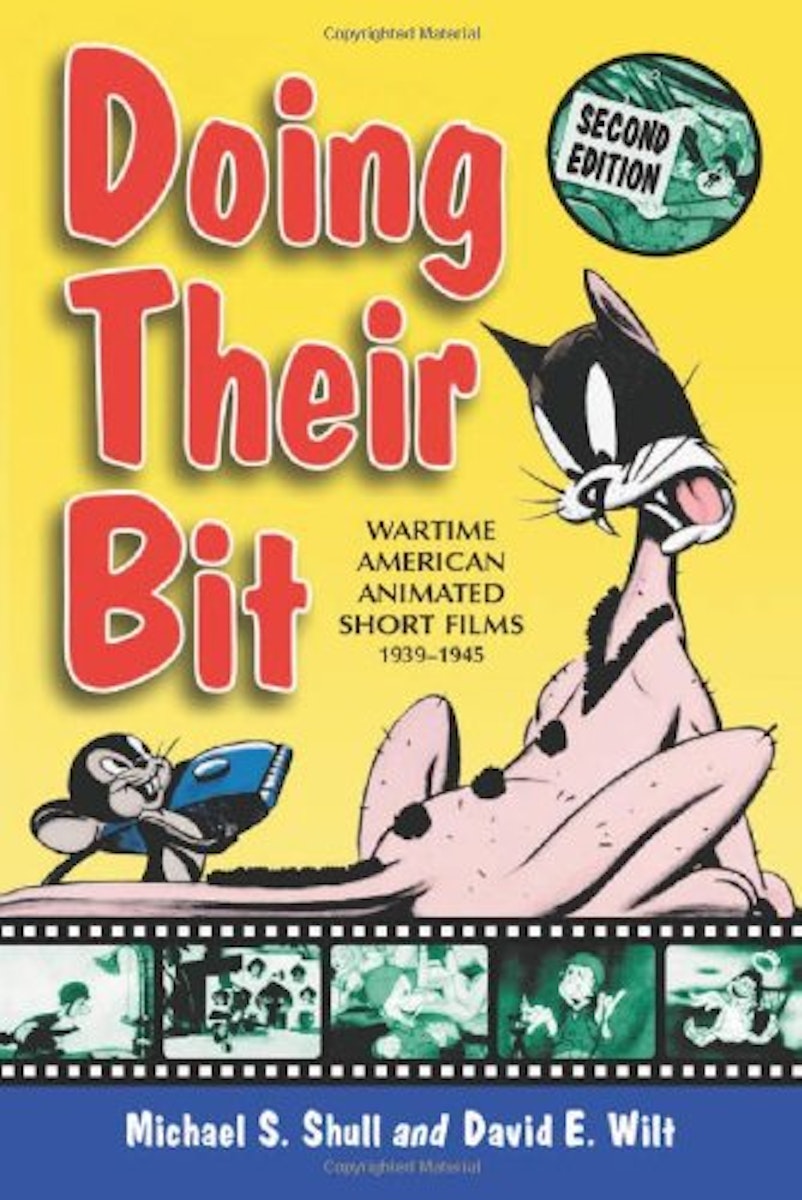
Ignorant Armies Private Snafu Goes to War
Between 1943 and 1945, with the help of Warner Bros.' finest, the U.S. Army produced a series of 27 propaganda cartoons depicting the calamitous adventures of Private Snafu. Mark David Kaufman explores their overarching theme of containment and how one film inadvertently let slip one of the war's greatest secrets.
March 25, 2015
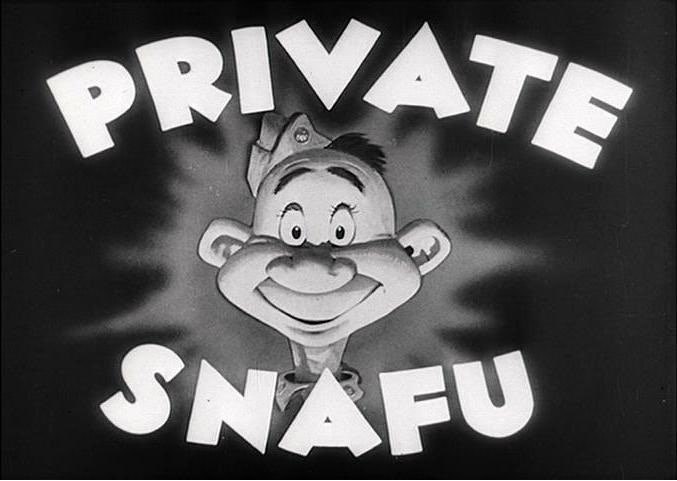 Scroll through the whole page to download all images before printing.
Scroll through the whole page to download all images before printing.Opening card of the U.S. army WWII short animated films “Private Snafu”, 1943 — Source.
In early 1942, with America still reeling from the attack on Pearl Harbor, Hollywood mobilized for war. Soon, silver-screen luminaries like Jimmy Stewart and Clark Gable were pinning wings to their lapels, making the roster of the U.S. Army Air Forces look like the opening credits of an MGM blockbuster. And while Tinseltown bristled with shiny new uniforms and all-too-perfect smiles, neighboring Toontown was also banging the proverbial drum. From Walt Disney to Warner Bros., the animation studios were letting slip the dogs — and ducks — of war. Donald, of course, was a natural recruit (he’s a sailor, after all). The feathered hero saw action in the jungles of Asia, braving snipers and ravenous crocodiles to single-wingedly wipe out an enemy airbase. Not to be outdone, Daffy proved that he too was a bird to be reckoned with. In 1943, the fowl-mouthed mallard parachuted commando-style behind German lines to wage unholy and untranslatable havoc. Others followed suit: Popeye punched Nazis, Superman sunk ships, and Bugs Bunny peddled war bonds. For these veterans of paint and light, it was a merry war, a loony war, and for none so much as for the army’s secret mascot: Private Snafu.
Every G.I. worth his creamed chipped beef knew the acronym, but when it first appeared on the barracks screen in a cartoon titled Coming! Snafu! in June of 1943 — the first of twenty-seven such films produced between 1943 and 1945 — the boys were greeted with a more wholesome interpretation: “Situation Normal, All . . . Fouled Up!” Even watered down, this would seem a curious mantra for a series of training films aimed at preparing enlisted men for the challenges of modern world warfare — that is, until one meets the protagonist. Introduced, tongue-in-cheek, as “a patriotic, conscientious guy who thinks the army’s swell,” Private Snafu is a short, bald, motor-mouthed Brooklynite with a penchant for catching tropical diseases, leaking classified information, and accidentally blowing himself up. He is, in sum, a shining example of what a soldier should not be, and he stands as a testament to how the military brass evidently viewed G.I. Everyman: naïve, careless, and perpetually horny.
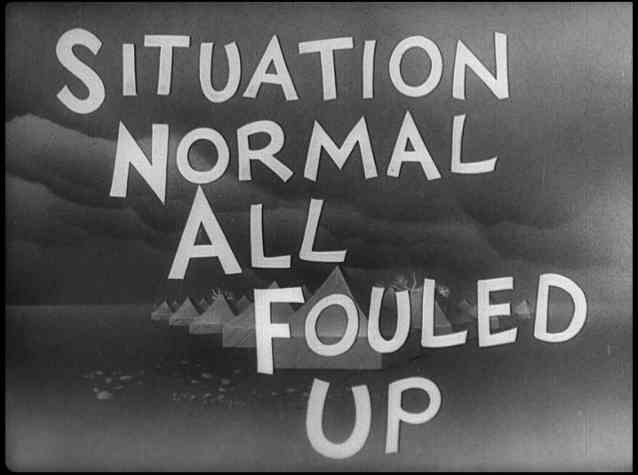 Scroll through the whole page to download all images before printing.
Scroll through the whole page to download all images before printing.Family friendly version of the phrase behind the acronym of SNAFU — Source.
The cartoons were the product of an extraordinary collaboration. During the Second World War, the production of propaganda and training films fell to the First Motion Picture Unit, a motley crew of actors, artists, writers, and filmmakers under the supervision of Hollywood director Frank Capra, that champion of small-town American values who had already given the world Mr. Smith Goes to Washington (1939) and would go on to direct It’s a Wonderful Life (1946). As the ringleader of this circus, Major Capra — later Colonel Capra — oversaw not only the Snafu shorts but also the highly successful Why We Fight series, which would win him an Academy Award for “Best Documentary” in 1943. Typically, these projects were outsourced to local studios with the necessary time and resources at their disposal. When it came down to finding a group of animators willing to take on Private Snafu, Disney proved too expensive and too dictatorial, and so the contract went to Leon Schlesinger’s Warner Bros. Cartoons studio. At the time, the boys of “Termite Terrace” (as the studio was known) were still relatively obscure. In retrospect, though, the talent roster behind the Snafu cartoons reads like a pantheon of animation icons: Chuck Jones, Friz Freleng, Bob Clampett, Frank Tashlin, and the “Man of a Thousand Voices” himself, Mel Blanc. Into this mix, add Theodor Geisel (a.k.a. “Dr. Seuss”), then working as a political cartoonist for the leftist New York newspaper PM, and the merry mashup is complete.
With so many dangerous minds on the job, it’s little wonder that work on the cartoons was carried out in the utmost secrecy. The security measures, which divided up production duties among different departments whose individual workers were not permitted to see the finished films, make the Warner Bros. operation look like a parody of the Manhattan Project. But in spite of the hush-hush atmosphere, the subject matter seems harmless enough on the surface. The twenty-six surviving episodes — all black-and-white — run the gamut of military safety topics: everything from how to maintain proper hygiene in the field, to what to do when faced with a squadron of malarial mosquitos, to why it’s simply not a good idea to go skipping through a mine field. In Bob Clampett’s Fighting Tools (1943), for example, Private Snafu learns that keeping his rifle muzzle-down in the mud can lead to a sticky situation when caught off guard by a Wehrmacht patrol. Similarly, in Chuck Jones’s Gas (1944) — an episode in which Bugs Bunny makes a brief cameo — Snafu learns the value of keeping his gas mask handy when poisonous clouds of Teutonic nastiness catch him napping under a tree.
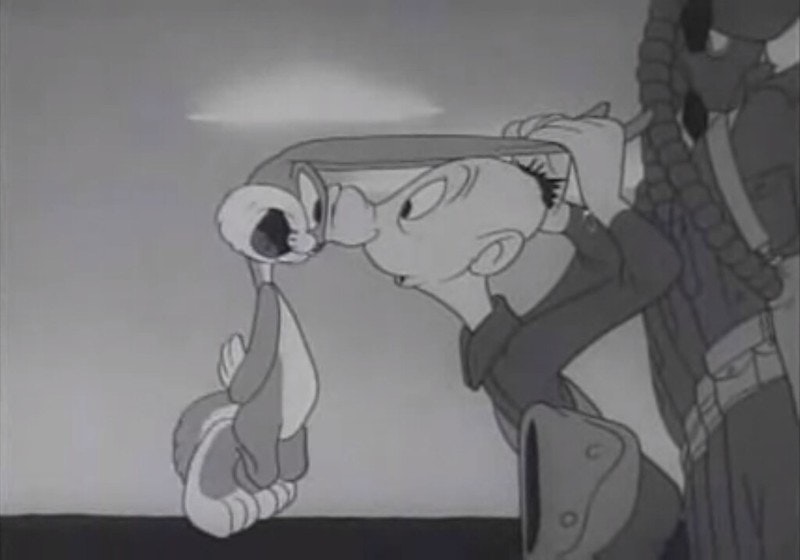 Scroll through the whole page to download all images before printing.
Scroll through the whole page to download all images before printing.Still from Gas (1944), showing Bugs Bunny’s brief cameo, Snafu mistaking him for a gas mask — Source.
Other cartoons foreground the challenges of working in exotic climes, such as Jones’s (ironically-titled) In the Aleutians — Isles of Enchantment (1945) and Freleng’s Hot Spot (1945), which finds Snafu humping it out in the deserts of occupied Iran. Still others focus on the basic necessities, like keeping a proper diet on the march. In Frank Tashlin’s bizarre The Chow Hound (1944), the ghost of a slaughtered bull presides over its own devouring, growing furious as the puerile private throws out perfectly good chunks of carcass. The moral: don’t waste chow. It dishonors the beasts who nobly volunteered to be “processed” for the cause.
Although such cock-and-bull stories may have had the desired effect of teaching soldiers the facts of military life, this didactic function obscures a more crucial one, that of providing an outlet for resentment while simultaneously defusing popular misconceptions, like the rumor that other branches of the service are safer and more glamorous (Three Brothers, 1944) or the nagging suspicion that everyone back home is having a ball while the grunts are out risking their lives (The Home Front, 1943). In effect, these cartoons are a form of officially sanctioned subversion, a kind of Foucauldian pressure valve designed to vent the average soldier’s discontent, releasing just enough anarchic energy to keep the system functioning. Take, for instance, Gripes (1943). Directed by Freleng, this short opens with Snafu on kitchen patrol, scrubbing pots, peeling potatoes, and, well, griping:
I joined this here army to join in the fun,
A-jabbin’ the Jap and a-huntin’ the Hun.
And look at the job that they handed to me:
KP, KP, KP, and KP!
After cataloguing more woes of army life — long lines, longer needles, and endless hours in the infirmary — the soldier’s thoughts turn to mutiny. Fortunately, Snafu’s imagined rebellion is interrupted by his personified military conscience: the gravely-voiced, cigar-smoking, perpetually five-o’clock-shadowed Technical Fairy, First Class. This cuddly sergeant with wings plays an avuncular role in the cartoons, managing, on occasion, to prevent the private from dismembering or otherwise making a fool of himself.
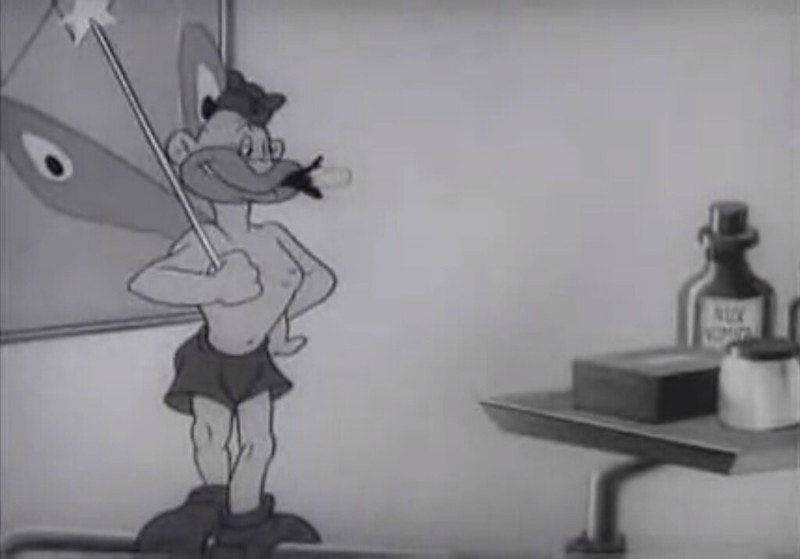 Scroll through the whole page to download all images before printing.
Scroll through the whole page to download all images before printing.Still from Gripes (1943), showing the Technical Fairy — Source.
In this case, the Technical Fairy shows Snafu a vision of what would happen if he were in charge. Upon receiving his fantasy promotion to “Master-Sarge-Super-Sarge-Whoopity-Doo,” Snafu proceeds to issue a series of dictums. No more cleaning latrines. No more discipline. Instead, each enlisted man will be provided with “two dames” and an extended leave pass. As charming as this image of state-sponsored prostitution may be, it all goes pear-shaped when the Germans make a surprise attack. With his troops intoxicated and the Luftwaffe bearing down, Snafu decides it’s better to take a needle in the tuckus than an incendiary bomb where the stars and stripes don’t shine. The fantasy dissolves. Hierarchy is restored. And while the private happily scrubs his pots and pans, the Technical Fairy dishes out wartime ethics: “The moral, Snafu, is the harder you work, / The sooner we’re gonna beat Hitler, that jerk.” Many of the Snafu shorts follow a similar pattern: the activation of dangerous desires, which are then disarmed by the narrative logic of the cartoon itself.
This form of vicarious indulgence is also evidenced by the films’ rather frank depictions of sexuality, which were more — shall we say — developed than one would expect from cartoons of that era. Because military films did not have to be approved by the Hays Office — the body responsible for enforcing the Motion Picture Production Code — the animators could push the boundaries of adult humor in ways that conventional Hollywood could not. In addition to suggestive language, the cartoons abound with buxom cabaret dancers, eager girls-next-door, and mysterious femmes fatales. These virtual pin-up queens, clearly intended to appeal to a G.I. aesthetic, invite a curious sort of voyeurism. From a contemporary perspective, this peephole on the past can be a bit disturbing; watching a seventy-year-old image of a cartoon vixen bending over her vanity table in nothing but a garter belt, one suddenly has the uneasy realization that one is ogling the grandmother of Jessica Rabbit. But for the lonely soldiers who first saw these films, representations of women served simultaneously as erotic outlets and warnings against being distracted by long legs and batting eyes. For example, in Booby Traps (1944), directed by Bob Clampett, we find our hero in the desert “liberating” a local harem. The only problem is that this bevy of bombshells is actually a nest of homicidal fembots whose curves are (quite literally) explosive.
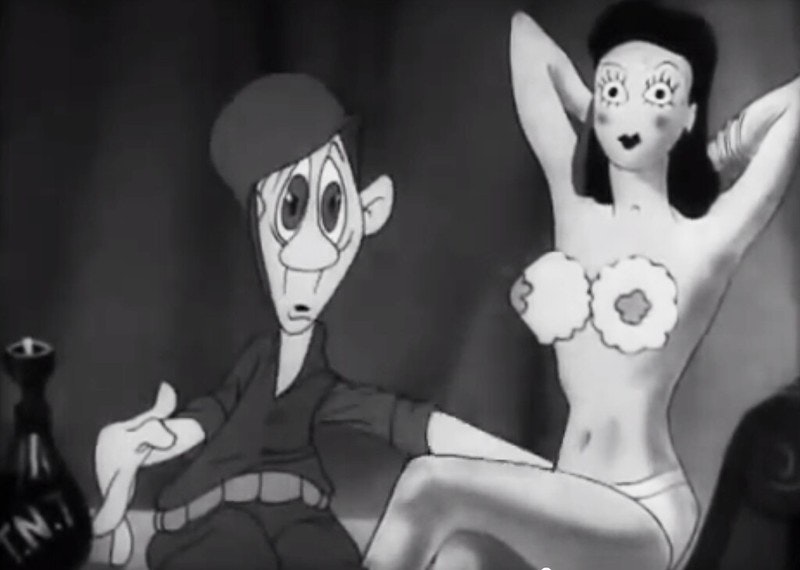 Scroll through the whole page to download all images before printing.
Scroll through the whole page to download all images before printing.Still from Booby Traps (1944), Snafu discovering the fembot’s behind is made of bombs — Source.
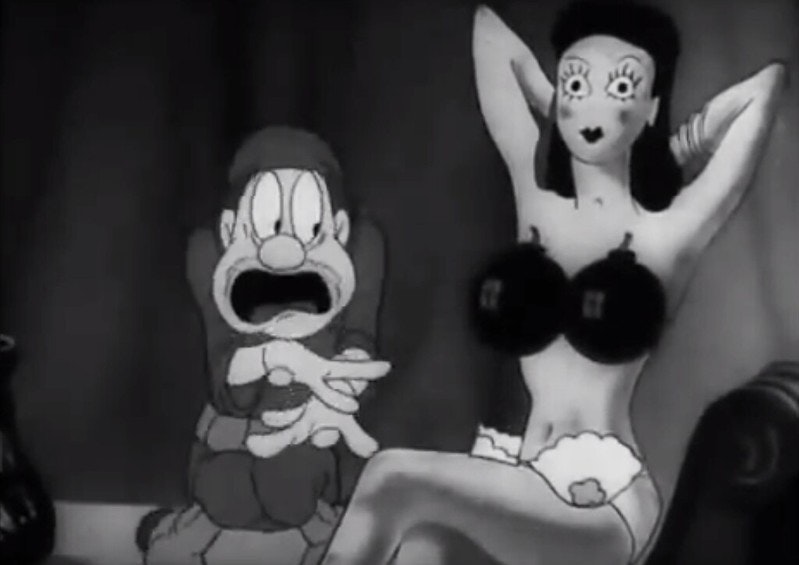 Scroll through the whole page to download all images before printing.
Scroll through the whole page to download all images before printing.Still from Booby Traps (1944), Snafu discovering the fembot’s breasts are also made of bombs — Source.
In Snafu’s world, women — with the possible exception of one’s mother — are not to be trusted. Indeed, the only long-term relationship that seems to work out is the odd rapport between the private and his Technical Fairy. On at least one occasion, the happy ending culminates with an image of Snafu and his imaginary NCO engaged in a big, wet kiss. (Don’t ask. Don’t tell.)
Each of these overarching themes — the preservation of bodily integrity, the mitigation of resentment, and the negation of female sexuality — boils down to one predominant concern: containment. And of all the tropes of containment found in the cartoons, the most persistent is the control of information. With titles like Spies (1943), Rumors (1943), and Censored (1944), the Snafu films present a primer on keeping one’s mouth shut. Of these, Chuck Jones’s Spies is the most memorable. Composed in Seussian verses, Spies finds the loquacious private home on leave with a head full of confidential plans regarding troop deployments to Africa:
I just learned a secret—
It’s a honey, it’s a pip!—
But the enemy is listening,
So I’ll never let it slip.
‘Cause when I learn a secret,
Boy, I zipper up my lip!
The enemy is indeed listening. And Snafu, chronically unable to keep his zipper up in any situation, goes about unaware of the sinister stereotypes — beefy Teutons, toothy Japanese, and alley cats with gingivitis — who are poised to pick up scraps of intelligence. Stopping at a newsstand, Snafu greets the pornography-peddling proprietor — “Hey, give me some magazines to read for when I’m on the ship!” — and his careless words are overheard by three bystanders who look suspiciously like Benito Mussolini, Hermann Goering, and Fumimaro Konoe.
 Scroll through the whole page to download all images before printing.
Scroll through the whole page to download all images before printing.Still from Spies (1943), showing the Mussolini, Goering, and Konoe look-a-likes eavesdropping at the news stand — Source.
“Don’t breathe a word to no one,” they chant, “but he’s going to go by ship!” Cut to Snafu at the local watering hole, where a heady combination of booze and broads erodes the “pad-a-lock” in his brain, releasing a gush of useful information into the ready lap of a femme fatale who packs a mini-typewriter in her garter. “Say, you’re a nifty trick,” he drunkenly tells her. “I hope I meet some babes in Africa as cute as you are!” Later, in her lair, Snafu manages to drop a final, crucial detail —
It’s been a wonderful evening,
And I’d like to stay some more,
But I gotta get a move on—
I sail at half past four!
— at which point the Aryan beauty’s breasts transform into swastika-shaped radio transmitters with a direct line to the Führer, who, upon receiving these titbits, dispatches a pack of U-boats to intercept the transport. The ship is torpedoed, and the private finds himself in a fiery cauldron lorded over by a hellish Hitler. Apparently, not even a guardian fairy can prevail over the uncontrollable desire to self-destruct, a compulsion that wends its way through the cartoons with the obstinacy of a death drive.
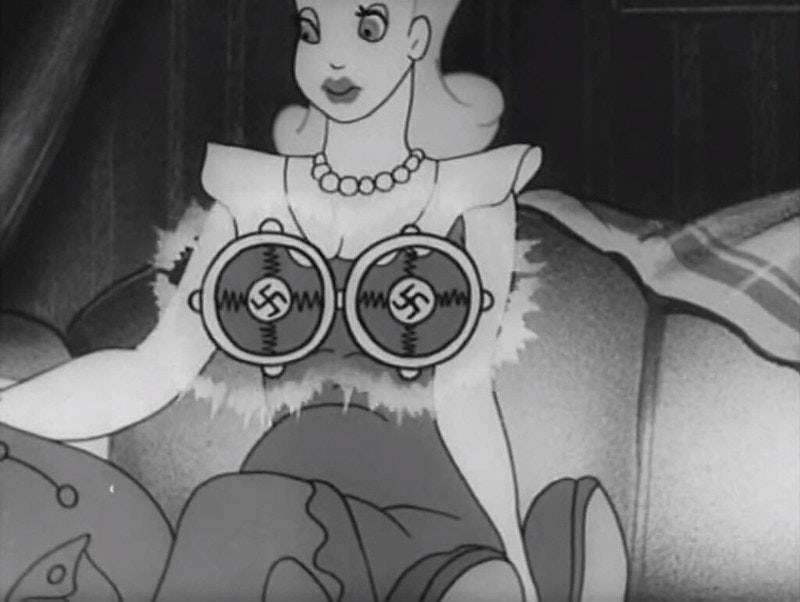 Scroll through the whole page to download all images before printing.
Scroll through the whole page to download all images before printing.Still from Spies (1943), the swastika-shaped radio transmitters — Source.
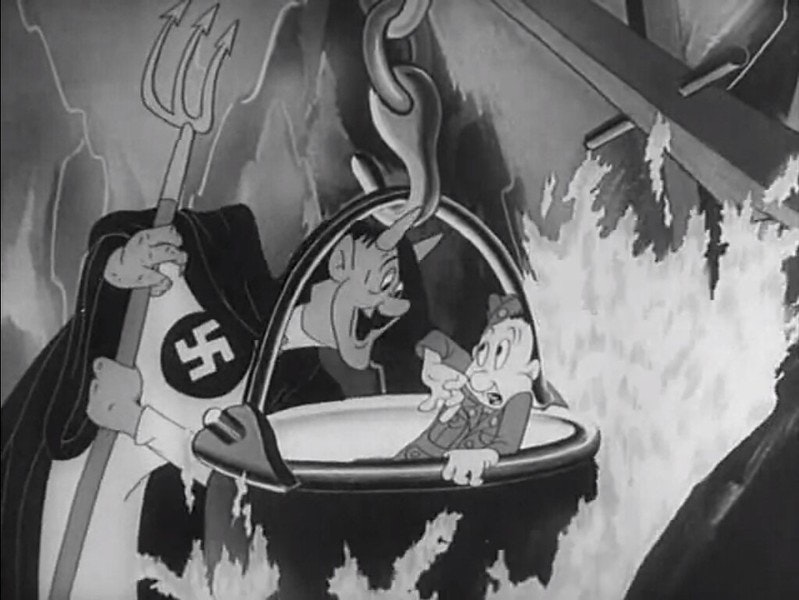 Scroll through the whole page to download all images before printing.
Scroll through the whole page to download all images before printing.Still from Spies (1943), Snafu in a cauldron lorded over by a hellish Hitler — Source.
For all their preoccupation with secrecy, however, one still wonders why the cartoons themselves were kept confidential. What was so dangerous about personal hygiene? Did it really matter if the Germans found out that U.S. servicemen were being encouraged to keep information from the Germans? In short, what was the big secret? As it happens, there was a big secret — a really big secret — but one unknown to the directors, writers, and artists who inadvertently let it slip. In May of 1944, Jones and his team produced Going Home. Penned (most likely) by Geisel, the cartoon was intended as yet another warning against loose lips on leave. Upon arriving back in his hometown, Snafu proceeds to regale a succession of family members, girlfriends, bartenders, and gas station attendants with tales of Allied maneuvers, new landing field designs, and other “restricted stuff.” Then — in one of those cosmic coincidences that reaffirm one’s belief in God, Loki, or the Illuminati — the cartoon takes a singularly prophetic turn. Snafu brings a date to the local movie theater, where a newsreel flashes: “U. S. SECRET WEAPON BLASTS JAPS.”
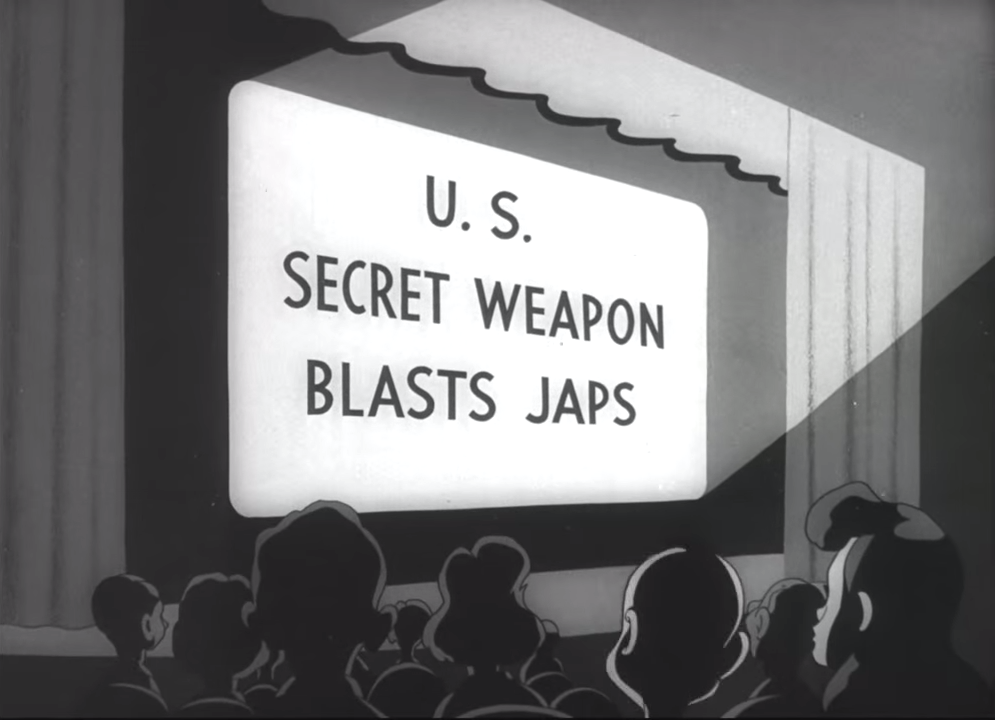 Scroll through the whole page to download all images before printing.
Scroll through the whole page to download all images before printing.Still from Going Home (1944), the newsreel headline announcement — Source.
The headline is followed by an image of an island reduced to a void, like a wound in the water. Snafu grabs his girl and whispers (loudly):
I know what did it —
What made the big hole —
Our new flyin’ bazooka
With radar control.
As the imprudent private gives a rundown of the weapon and its features, the viewer sees a vaguely familiar image, more bomb than bazooka, with mysterious valves and menacing fins.
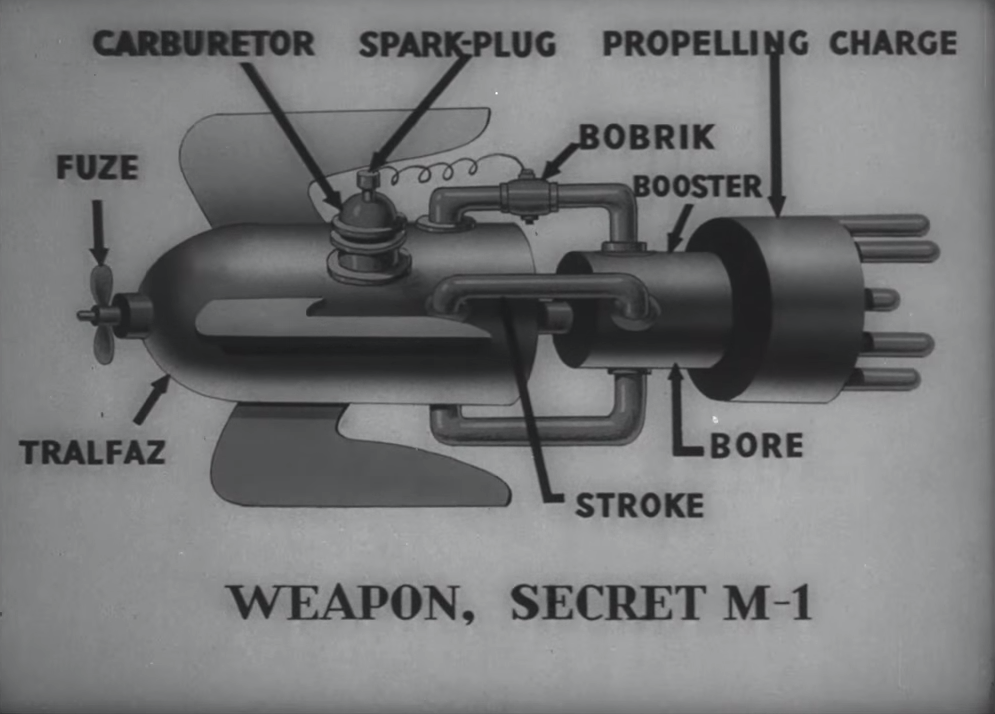 Scroll through the whole page to download all images before printing.
Scroll through the whole page to download all images before printing.Still from Going Home (1944), the secret weapon, more like bomb than bazooka — Source.
This, once again, was the spring of 1944. At that very moment, grave-looking scientists in remote desert bunkers were smoking cigarettes, poring over blueprints, and ordering shipments of uranium-235. When the powers-that-be got wind of the fact that Warner Bros. had independently invented the atomic bomb, shady departments flew into action. The cartoon was pulled, not to see the light of day until some years after the war, and the filmmakers, who had no clue as to what was happening, suddenly found themselves in the middle of a poorly written spy thriller, complete with intimidating visits from government spooks in homburgs and trench coats. There were no prosecutions, of course. How could there have been? To do so would have meant acknowledging the existence of the Manhattan Project over a year before the bombings of Hiroshima and Nagasaki. Not to mention that this was no conspiracy, but rather an accident of ink, paint, and imagination. All the same, this chance unveiling reminds us that cartoons are themselves sites of fusion, crucibles where technology, violence, and creativity combine in ways that collapse the divide between reality and fantasy, leaving us to ponder which is more disturbing: the fact that these comic minds could randomly hit upon the most significant breakthrough in modern warfare, or that the scientists responsible for designing and building the most destructive weapon in human history — a device capable of eradicating all life on Earth in the blink of an eye — seemed to share so much in common with the creator of Wile E. Coyote.
Perhaps the ultimate irony is not that a series of military training films obsessed with maintaining secrecy nearly let the bomb drop, but that the Snafu cartoons, which flirted so promiscuously with subversion as a mode of catharsis, accidentally succeeded in becoming genuinely subversive. Nevertheless, when the reels were shelved after the war, it’s doubtful this was due to their military indiscretions, but more likely out of fear that their racial caricatures would offend a newly rehabilitated Germany and Japan. Now declassified and available in the public domain, the films offer a glimpse of a time before enemies became friends and friends enemies, before the Cold War ushered in a new situation, even more fouled up, in which Snafu’s “secret weapon” threatened — and continues to threaten — an ending with no merry melody, no curtain drawn, and no Porky Pig to stammer “That’s all, folks!”
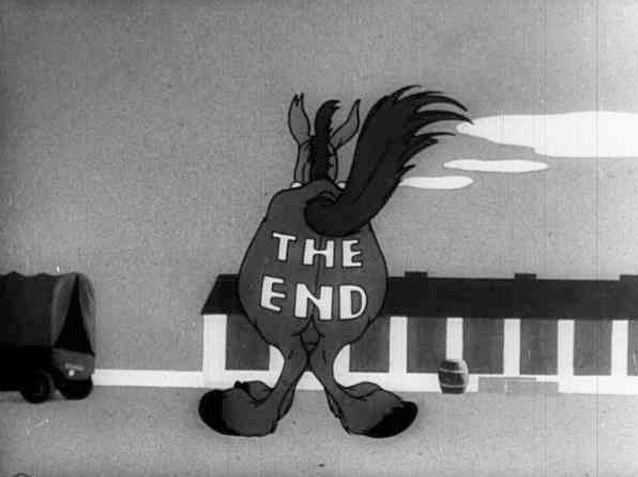 Scroll through the whole page to download all images before printing.
Scroll through the whole page to download all images before printing.Mark David Kaufman received his Ph.D. in English literature from Tufts University. He has published critical essays in Hypermedia Joyce Studies and Biography: An Interdisciplinary Quarterly. Currently, he is at work on a book project, tentatively titled Secret States: Modernism, Espionage, and the Official Secrets Act. For more information, please visit his website: www.markdavidkaufman.com.





